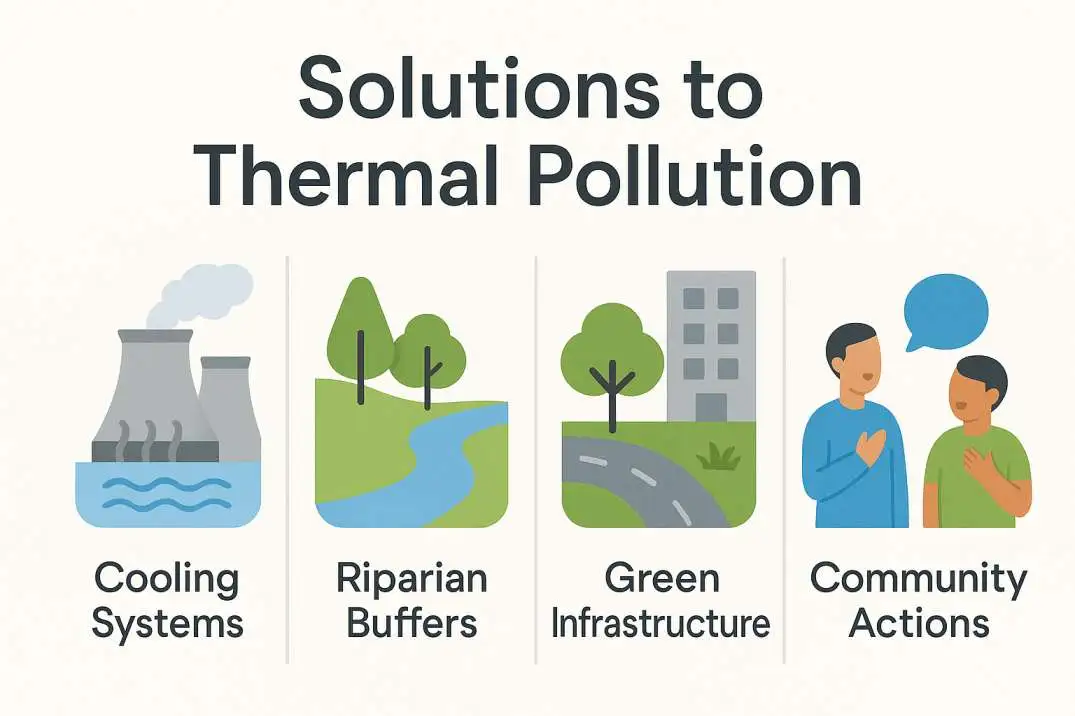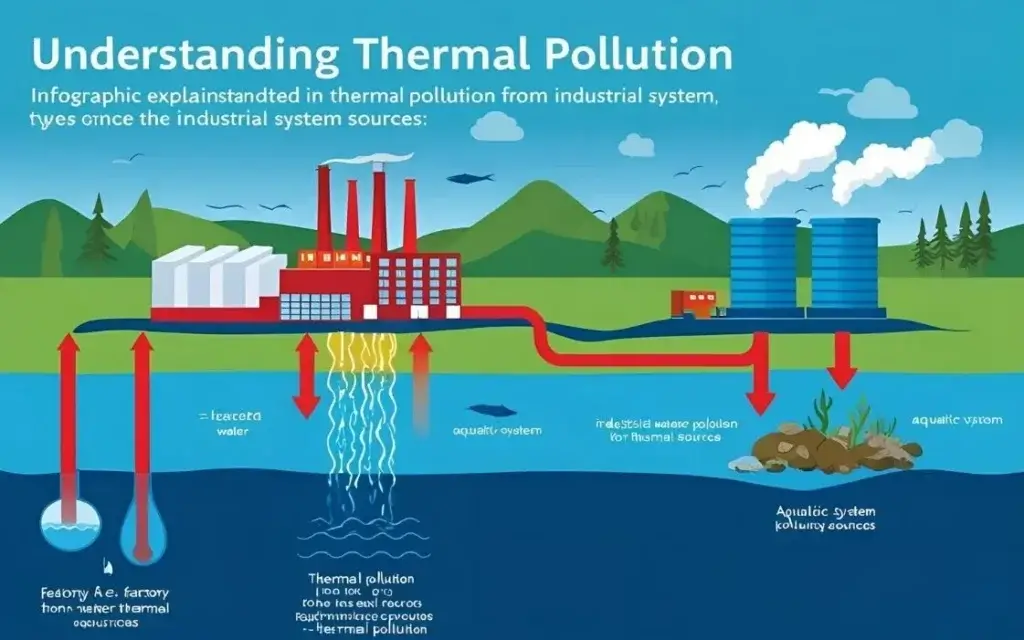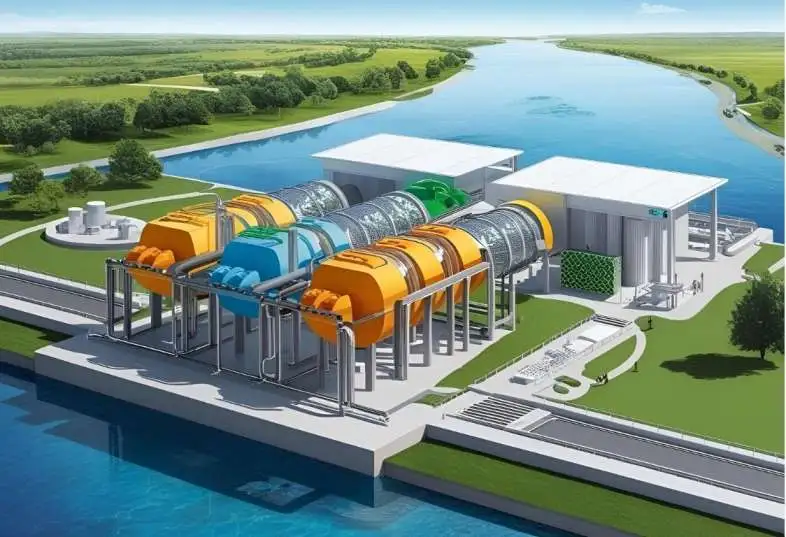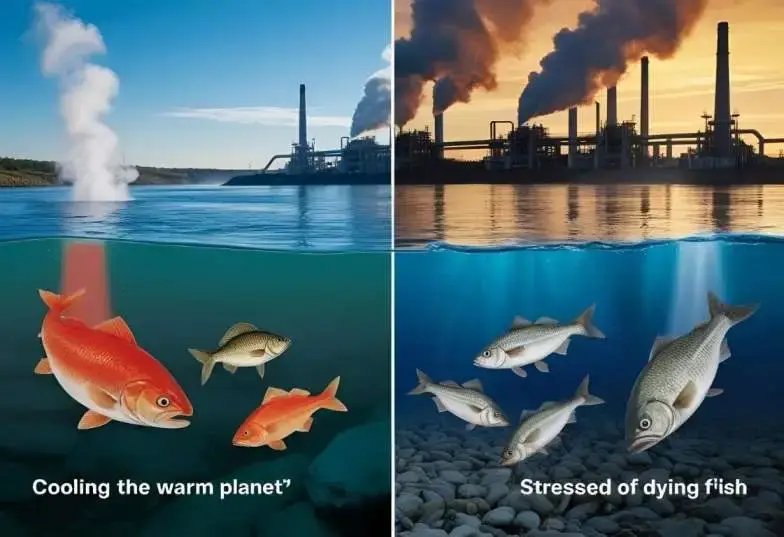Introduction
Solutions to Thermal Pollution are more important today than ever before. Have you ever wondered how warm water from factories and power plants can harm rivers and lakes? This problem, called thermal pollution, is a hidden threat to our environment. In simple words, thermal pollution happens when people make water too hot for fish, plants, and other living things to survive.
In India and around the world, many industries use water to cool their machines. When they release this warm water back into nature, it can lower oxygen levels, kill sensitive species, and upset the natural balance of entire ecosystems. This problem affects not just wildlife but also communities that rely on clean water for farming, fishing, and daily life.
The good news is that many effective solutions to thermal pollution exist. From modern cooling systems and smart technology to planting trees along riverbanks, there are proven ways to reduce harmful impacts. In this guide, you’ll discover practical steps, inspiring examples, and simple tips to help fight thermal pollution and protect our precious waterways. Whether you are a student, an eco-friendly parent, or a sustainability professional, you’ll find helpful ideas you can use today.

Table of Contents
Understanding Thermal Pollution and Its Effects
What Is Thermal Pollution?
Thermal pollution means water gets too warm because of human activities. This often happens when factories and power plants use rivers or lakes to cool their machines. The hot water goes back into nature, raising the temperature of streams, ponds, and rivers.
For example, in India, many coal-based power plants release warm water into nearby rivers. During summer, this can make the water even hotter, creating a stressful environment for fish and other animals.
It’s not just big industries. Cities also cause thermal pollution. Roads, rooftops, and parking lots absorb heat from the sun. When it rains, hot water flows into drains and ends up in rivers, warming them up.

Why Is It Harmful?
Warm water might sound harmless, but it can cause serious problems for nature:
- Less oxygen: Hot water holds less oxygen. Fish and plants that need cool, oxygen-rich water can die.
- Disrupted life cycles: Many fish lay eggs only in cool water. If the river gets too warm, they stop reproducing.
- More algae growth: Warm water can cause algae to grow quickly. This makes the water green and dirty and uses up even more oxygen.
- Changes in species: Some species that like warm water take over, while native fish and plants disappear.
For example, the Kanhan River in Maharashtra has suffered from thermal pollution due to power plants. Fish populations have dropped, and people who rely on fishing have lost income.
Quick Tip:
If you live near a river or lake, pay attention to how warm the water feels after rain or near factories. This simple observation helps you understand how human actions change natural systems.
Thermal Pollution Case Studies
Here are some real examples of thermal pollution around the world:
India – Kanhan River
Coal power plants in Maharashtra made the Kanhan River 6 to 8 degrees warmer. Many fish died, and there were fewer types of animals in the river. To fix this, the plants started using closed cooling systems and planting trees along the river.
United States – Hudson River
A power plant called Indian Point heated the Hudson River by 7 to 10 degrees. This hurt fish like the Atlantic tomcod. After many years, the plant closed. Now, the river is slowly getting better.
United States – Columbia River
In the Columbia River, dams and fewer trees have made the water too warm for salmon. The salmon cannot swim and lay eggs in such hot water.
Germany – Rhine River
A nuclear power plant made the Rhine River 3 to 5 degrees warmer. Fish had trouble living there, and green algae grew too much. Later, cooling towers were built, and the river improved.
China – Yangtze River
Power plants and dams heated the Yangtze River by 4 to 7 degrees. Many local fish started to disappear. China is now building better cooling systems and wetlands to cool the water.
Technological Solutions to Thermal Pollution
One of the best ways to solve thermal pollution is by using better technology. Many factories and power plants are now switching to systems that reduce how much heat they send into rivers and lakes.
Closed-Loop and Dry Cooling Systems
In older power plants, water is taken from a river, used once to cool machines, and then sent back out as hot water. This is called once-through cooling. It wastes water and heats up the environment. A better method is the closed-loop cooling system. Here, the same water is used again and again. It goes through a cooling tower before being reused. This cuts water use by up to 95% and keeps rivers cooler.
Dry cooling systems go one step further. These use air instead of water. Big fans blow air over hot pipes, like a giant radiator. This system is more expensive but works well in places where water is limited. It also completely avoids thermal pollution.
Waste Heat Recovery and Smart Discharge
Another smart solution is to reuse waste heat instead of dumping it. This is called waste heat recovery. Some factories use extra heat to warm nearby buildings, greenhouses, or even fish farms. This turns waste into a useful resource.
Smart discharge systems help reduce harm to aquatic life. These systems use sensors and computers to choose the best time to release warm water, such as at night or during cooler weather. This avoids hurting fish during spawning or migration seasons.
These modern solutions are already working in parts of India. For example, newer power plants in Gujarat and Tamil Nadu are using closed-loop systems to reduce heat discharge into rivers.
While the technology behind these systems can be complex, the goal is straightforward: to protect rivers and lakes so all forms of life can thrive.

Natural and Landscape-Based Cooling Approaches
Not all solutions to thermal pollution rely on machines. Sometimes, nature itself offers the best ways to cool water and protect the environment. These methods are often cheaper and add beauty to the landscape.
Riparian Buffers and Tree Planting
A riparian buffer is a strip of trees and plants along a river or lake. These trees provide shade that keeps water cool, especially in the hot summer months. Their roots also help prevent soil erosion and filter out pollution before it reaches the water.
Planting native trees along rivers is one of the easiest ways to fight thermal pollution. In India, projects along the Ganga and Yamuna rivers have shown that tree planting can lower water temperatures by up to 5 degrees Celsius. It also brings back birds, fish, and insects that rely on healthy riverbanks.
If you live near a stream, you can plant trees or support local groups that work on riparian restoration. Even small community projects can make a big difference over time.

Green Infrastructure in Cities
Cities often cause thermal pollution when rainwater runs over hot surfaces like roads and parking lots. But green infrastructure helps slow down and cool this water before it reaches rivers.
Some good examples include:
- Rain gardens: Shallow gardens that collect rainwater and let it soak into the ground.
- Permeable pavements: Special surfaces that allow water to pass through instead of running off.
- Green roofs: Roofs covered with plants that absorb heat and rain.
Beyond simply cooling runoff water, these solutions also help manage flooding, improve air quality, and add green spaces that communities can enjoy. For example, in Bengaluru, rain gardens and green rooftops are being added to public buildings to manage stormwater and reduce heat.
Even homeowners can help by adding plants around their houses or choosing permeable tiles for driveways. Simple steps like these help protect rivers and keep city temperatures in check.

Policy, Education, and Community Action
While technology and nature-based solutions are important, laws and community efforts are just as essential to stop thermal pollution. Policies guide industries, and education empowers people to act.
Laws and Incentives
Many countries have rules that limit how much heat factories and power plants can release into rivers. In India, the Central Pollution Control Board sets temperature standards for wastewater. These rules help protect fish, plants, and people who rely on clean water.
Some governments also offer incentives to encourage companies to upgrade their cooling systems. For example:
- Tax breaks for installing closed-loop or dry cooling equipment
- Grants for companies that invest in waste heat recovery
- Recognition programs for businesses that follow eco-friendly practices
These policies motivate industries to take action without waiting for enforcement. When industries see clear benefits, they are more likely to invest in solutions.
How Communities and Students Can Help
Ordinary people can do a lot to fight thermal pollution. One way is through community monitoring programs. In some cities, volunteers help track water temperatures near industrial areas. This data shows when and where problems happen, so authorities can act quickly.
Schools also play a big role. Many science teachers now include water quality testing in lessons. Students learn how pollution works and what they can do to prevent it.
Here are a few simple actions anyone can take:
- Join local clean-up days along rivers and lakes
- Plant trees to shade streams
- Attend community meetings about water protection
- Report pollution to local authorities if you see hot water being discharged
In places like Kerala, citizen groups have helped plant trees along streams and set up small weather stations to measure temperature and rainfall. These efforts not only protect rivers but also build a sense of community.
Policies and community action work best when they go hand in hand. When everyone understands the issue and feels empowered to help, lasting change becomes possible.
Conclusion
Thermal pollution is a serious issue, but the solutions are within our reach. From advanced cooling systems in factories to planting trees along riverbanks, every step makes a difference. Green infrastructure in cities and smart laws also play a big role in keeping our water clean and cool.
Whether you’re a student, a parent, a city planner, or someone who cares about the planet, you have the power to help. You can start by learning more, planting trees, or even just spreading the word. Small actions, when done by many people, can lead to big change.
Thermal pollution may be hidden, but its impact is real. The good news is: so are the solutions. By utilizing the right tools, implementing smart policies, and collaborating, we can safeguard our rivers, our fish, and our future.
Let’s act now—for the climate, for the water, and for the generations to come.
Need a Summary or Quiz for Class?
Download Thermal Pollution Summary & Quiz PDF with infographic, summary & mini-quiz with infographic, summary & mini-quiz
Frequently Asked Questions About Thermal Pollution in India
Q: What are the main solutions to thermal pollution?
A: The primary solutions to thermal pollution include closed-loop and dry cooling systems, riparian buffer restoration, green infrastructure in cities, and policy-driven temperature standards to limit industrial heat discharge.
Q: How do power plants contribute to thermal pollution?
A: Power plants often use once-through cooling systems that discharge heated water into nearby rivers or lakes, significantly raising water temperatures and disrupting aquatic ecosystems.
Q: Why is thermal pollution harmful to aquatic life?
A: Thermal pollution reduces dissolved oxygen in water and alters species behavior, making it difficult for fish and other aquatic organisms to survive, reproduce, or migrate effectively.
Q: How can riparian buffers help reduce thermal pollution?
A: Riparian buffers provide natural shade that cools stream temperatures, stabilizes riverbanks, and supports biodiversity, making them a key solution to thermal pollution in both urban and rural settings.
Q: What role does urban development play in thermal pollution?
A: Urban areas with impervious surfaces like roads and rooftops heat stormwater runoff, which flows into streams and raises water temperatures, contributing to thermal pollution in developed regions.
Q: What policies exist to regulate thermal pollution?
A: Regulations often include temperature limits on discharges, seasonal restrictions, and the use of mixing zones. Some regions also employ market-based solutions, such as thermal credit banking.
Q: Are there technologies that eliminate thermal pollution?
A: Dry cooling systems and hybrid systems significantly reduce or eliminate thermal discharges, while waste heat recovery technologies convert excess heat into usable energy, offering sustainable solutions to thermal pollution.
Q: How does climate change affect thermal pollution?
A: Climate change amplifies thermal pollution by raising baseline air and water temperatures. This reduces the natural buffering capacity of water bodies, making them more vulnerable to heated discharges and stormwater runoff.
Want a printable summary of these thermal pollution solutions? Download the Free Thermal Pollution Summary & Quiz (PDF)
🚀 Join 10,000+ Eco-Warriors! Get Weekly Tips on Fighting Pollution + Free Thermal Pollution Cheat Sheet!
Want to learn more about Thermal Pollution?
- What is Thermal Pollution? Causes, Effects, and Solutions Explained→
- Causes of Thermal Pollution: Human vs Natural Sources
- Effects of Thermal Pollution on Aquatic Ecosystems: Causes, Case Studies & Solutions
About the Author
Soumen Chakraborty is an environmental writer who is passionate about sustainable solutions. He has researched and written about environmental issues for two years, breaking down complex topics into practical, actionable insights.
Last update on 09 July 2025
🌍 “Every small action matters in protecting our planet.”
Contact via: ecoplanet@greenglobe25.in

